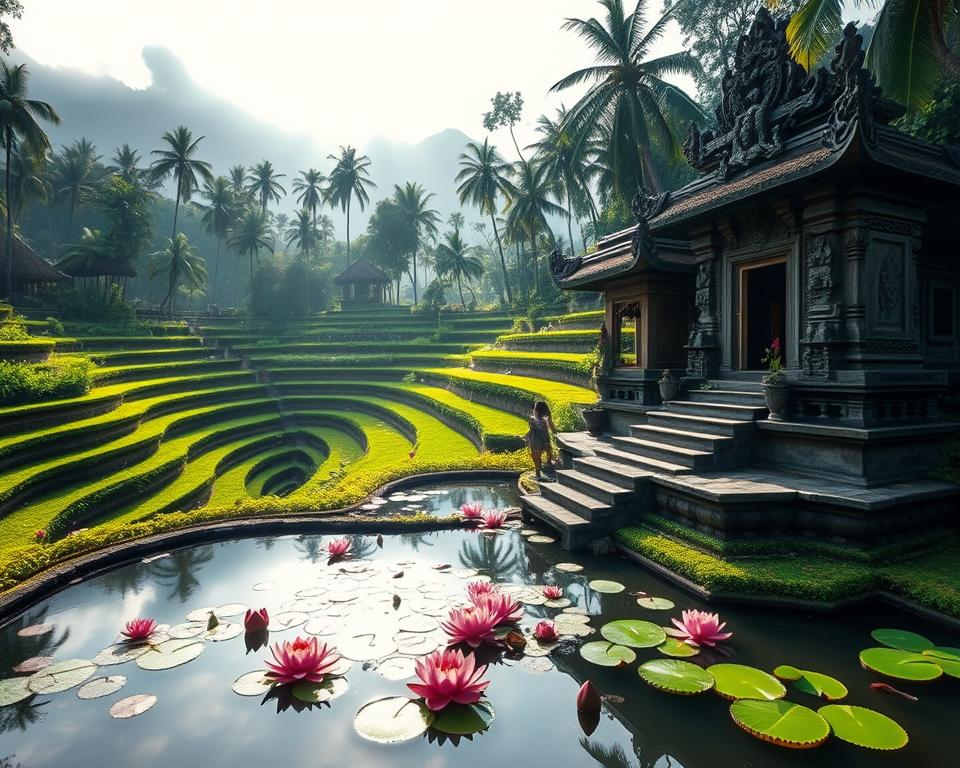
Ubud Water Temples
Did you know the Tirta Empul Water Temple in Bali was built in 926 A.D1.? This old Hindu temple and others in Ubud are famous worldwide. They have amazing architecture, sacred rituals, and water believed to heal.
Visiting these places shows how much Balinese people love water. It’s a special way to see their culture.
Key Takeaways
- Ubud in Bali is home to a collection of sacred water temples that draw visitors from around the world.
- These temples, such as the famous Tirta Empul, are renowned for their stunning architecture, ancient Hindu rituals, and the believed healing powers of their natural spring waters.
- Exploring these spiritual oases provides a unique insight into the deep reverence for water in Balinese culture.
- The Tirta Empul temple complex takes at least 30 minutes to an hour to fully explore1.
- The Tirta Empul temple is located approximately 14 km northeast of Ubud1.
Introduction to Ubud’s Water Temples
The spiritual heart of Bali is in its ancient water temples. Ubud is full of these sacred sites. They show the deep love for Balinese Hinduism and water worship2.
The Significance of Water in Balinese Hinduism
Water is very important in Balinese Hinduism. People go to natural springs and rivers to clean their bodies and souls. The water temples in Ubud, like Tirta Empul, were built around these places2.
The History and Origins of Ubud’s Water Temples
The oldest water temple in Ubud is Tirta Empul. It was built in 962 AD by King Sri Candrabhayasingha Warmadewa2. Many more water temples were built over time. They are places of purification and spiritual renewal2.
| Water Temple | Key Facts |
|---|---|
| Tirta Empul |
|
The water temples in Ubud are key to the town’s history and culture. They are deeply connected to Balinese Hinduism and water worship. These sites attract visitors worldwide, giving them a deep experience of Bali’s spiritual heritage23.
Tirta Empul: The Most Famous Water Temple
Tirta Empul is in Ubud’s green hills. It’s famous in Bali. It’s old, from 962 A.D., during the Warmadewa dynasty4.
This temple is special because of its natural spring pools. It’s also known for ancient rituals. The name means “holy water spring” in Balinese.
The Purification Rituals at Tirta Empul
Visitors love the ritual of melukat at Tirta Empul. It’s an old tradition. People clean themselves under 30 water spouts4 in the temple’s center.
The pools have names like Pengelukatan and Sudamala dan Pancuran Cetik (poison)4. Each pool has a special role in the ritual.
The Legend of Tirta Empul’s Creation
Legend says the temple was made by Indra. He hit the earth with his staff. This made the holy spring to help his army5.
This story makes the temple very special. The Balinese believe the water can purify and heal.
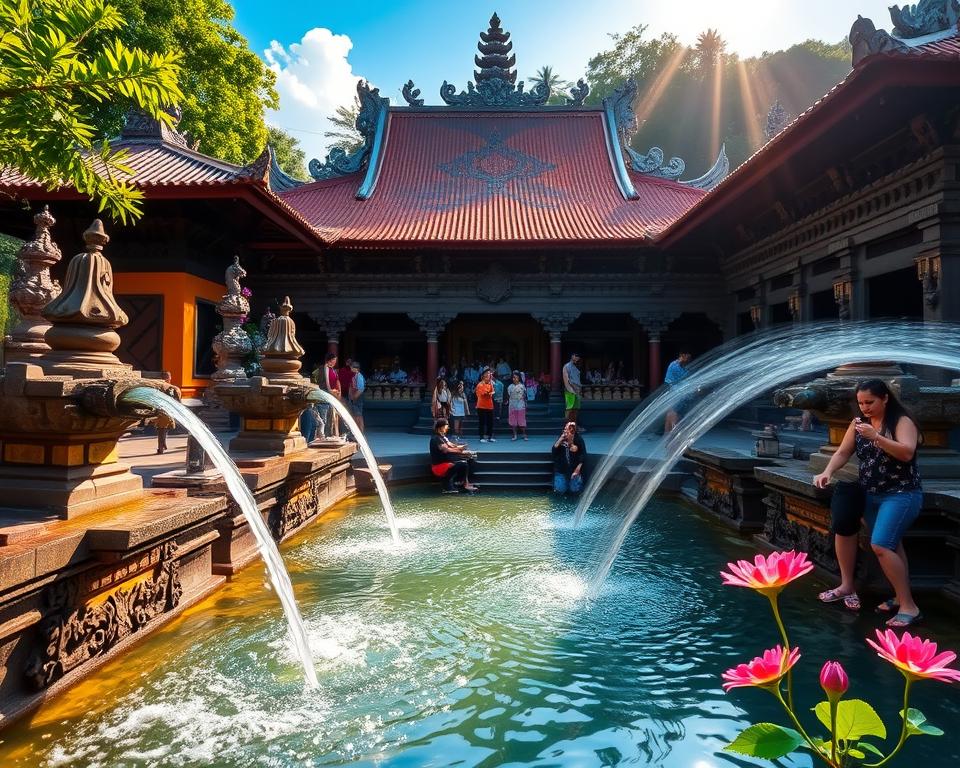
Recently, there were worries about pollution and health at Tirta Empul4. But, it’s a key place to see Bali’s culture and its holy waters.
Other Notable Water Temples in Ubud
Ubud is famous for its water temples, but there’s more to see. You’ll find many Balinese Hindu temples here. They are all about water and have their own stories and rituals.
Pura Ulun Danu at Lake Beratan
Pura Ulun Danu sits on Lake Beratan’s shore. It’s a temple for Dewi Danu, the lake goddess6. Built in the 17th century, it has tall shrines that look like they’re floating on water. It’s a sight to see.
Visitors can feel the temple’s calm. They can watch the Balinese Hindu rituals too.
Pura Tirta Tawar at Gianyar
Pura Tirta Tawar is in Gianyar town6. It’s famous for its healing spring. People come here for water rituals and to clean themselves.
The temple’s carvings show the Balinese people’s love for water.
| Temple | Admission Fee | Visitor Numbers | Key Features |
|---|---|---|---|
| Gunung Kawi Sebatu Temple | Rp 15,000 per person7 | Five visitors seen7 | Peaceful setting for meditation with a view over Cerik River |
| Tirta Empul Temple | N/A | Car park occupancy of more than 50 cars7 | Famous for its purification rituals and legendary origins |
| Tegenungan Waterfall | N/A | N/A | 40-minute drive from Tirta Empul Temple, with a shallow pool suitable for swimming7 |
These temples let you see Ubud’s water sites in a new way6. They’re great for quiet moments or learning about Balinese beliefs. Visiting these temples is a special experience.
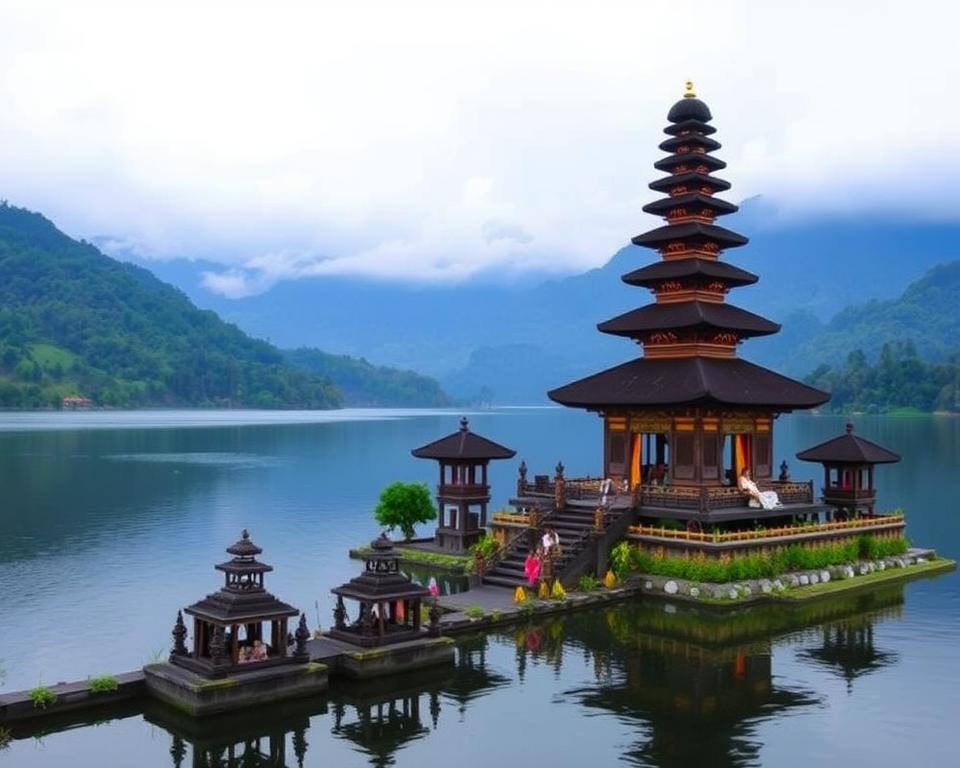
“Ubud is a place where you can get close to Bali’s fascinating spiritual traditions. Visiting the water temples is a great way to connect with the island’s rich cultural heritage.”
Ubud Water Temples
The water temples of Ubud are amazing. They show how much Balinese Hindus love water8. These temples are built near natural springs. They are places where people can clean their souls and feel close to the divine.
Places like Tirta Empul, Pura Ulun Danu, and Pura Tirta Tawar are special. They let visitors see Bali’s rich culture and faith9.
Ubud’s water temples are beautiful and spiritual9. You can see amazing carvings and sculptures. You can also see how Balinese Hindus pray.
These temples show water’s importance in Balinese life. Water is seen as life, clean, and a way to connect with the divine.
Visiting Ubud’s water temples is a must for culture lovers and those interested in Hinduism9. They are set in stunning landscapes. They have a deep history and spiritual meaning.
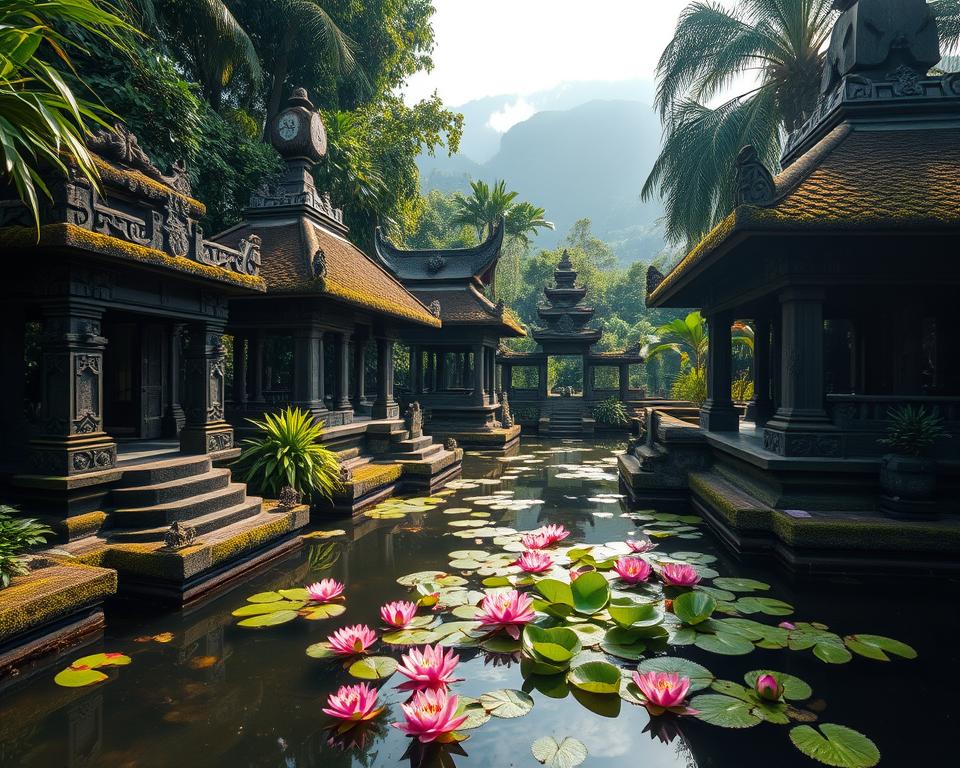
| Ubud Water Temple | Key Features |
|---|---|
| Tirta Empul | – The most famous water temple in Ubud – Site of purification rituals – Dates back to 926 AD10 |
| Pura Ulun Danu at Lake Beratan | – Located on the shores of Lake Beratan – Dedicated to the goddess Dewi Danu – Offers stunning views of the lake and surrounding mountains |
| Pura Tirta Tawar at Gianyar | – Lesser-known but equally significant water temple – Situated near the Pakerisan River – Part of an archaeological complex dating back to the 11th century10 |
Ubud’s water temples show the lasting impact of Balinese Hinduism10. They give visitors a chance to see sacred rituals and amazing architecture. These temples have amazed Balinese people for generations.
The Sacred Architecture of Water Temples
The water temples in Ubud are famous for their detailed designs11. They have carved stone gates, pavilions, and shrines. These show how important water is in Balinese Hinduism12.
Things like springs, pools, and water spouts have special meanings. They stand for water’s power to give life, clean, and renew12. The temples mix traditional Balinese styles with spiritual elements, creating a special blend.
The Symbolism and Design Elements of Water Temples
Balinese water temples mix Hindu symbols with local skills12. They are built to connect us spiritually with water’s life-giving power12. The temples are full of detailed carvings, each with its own meaning from Hinduism and Balinese culture.
- The springs in the temple show water’s pure start and its power to refresh and clean12.
- The ‘candi bentar’ stone gates mark the shift from everyday life to the temple’s sacred space12.
- The ‘meru’ pavilions, shaped like cosmic mountains, link earth and heaven12.
- Water spouts and fountains, shaped like mythical creatures, show water’s flow and cleansing power12.
The detailed designs of Ubud’s water temples show deep respect for water in Balinese beliefs12. These symbols make the temples a sacred place. They highlight the cultural and religious importance of these amazing buildings12.
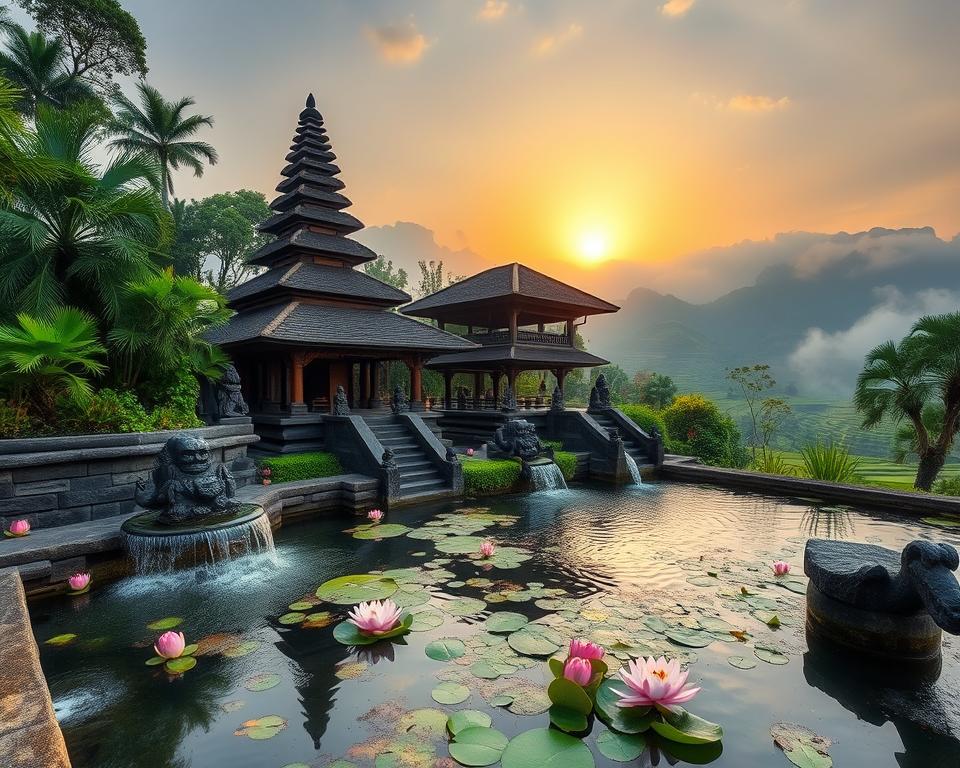
Visiting Ubud’s Water Temples
Going to Ubud’s water temples is a must for anyone visiting Bali. These places show the rich culture and spiritual ways of the Balinese. But, it’s key to know the right way to act and respect these places7.
Tips for Visitors and Proper Etiquette
Before you go in, you need to wear a sarong. You can rent one at the temple doors7. Also, take off your shoes when you enter. This is a sign of respect7.
Temple staff will guide you. They can teach you about the rituals and customs7.
Seeing the spiritual ceremonies is a highlight. But, don’t interrupt them. They are very important to the locals. Watch from afar and be respectful7.
Knowing the rules and being respectful lets you enjoy Ubud’s water temples fully. You’ll appreciate Bali’s culture more7.
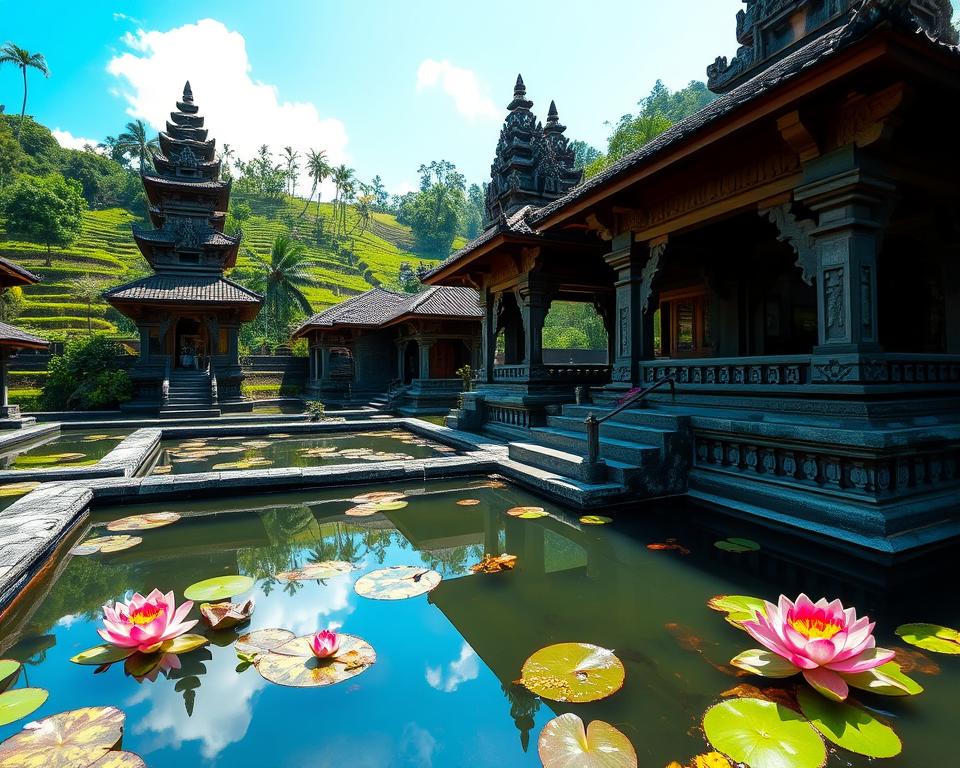
“The water temples of Ubud are not just architectural wonders, but sacred spaces that hold deep spiritual significance for the Balinese people. Approaching them with respect and mindfulness can truly enhance your understanding and appreciation of this remarkable cultural heritage.”
| Temple | Admission Fee | Duration Spent | Visitor Numbers |
|---|---|---|---|
| Gunung Kawi Sebatu Temple | Rp 15,000 per person | Approximately 30 minutes | A total of five tourists |
| Tirta Empul Temple | Not specified | Around 10 minutes (bathing area observation) | More than 50 cars parked |
| Tegenungan Waterfall | Not specified | Unspecified, but suggested as an afternoon activity | Not specified |
By following these simple guidelines and respecting the local customs, you can ensure a truly enriching and memorable experience as you explore the captivating water temples of Ubud7.
The Role of Water Temples in Balinese Culture
Water temples are key in Balinese culture. They are places for purification, healing, and connecting with the divine13. People bathe in the temple’s water to clean themselves. This belief comes from the idea that water can remove impurities and bring balance.
The Spiritual Significance of Water Purification
Ubud’s water temples are more than buildings. They are sacred spaces for the Balinese people’s well-being13. Visitors often feel peace and joy after these rituals13. The temple has rules for visitors, like wearing certain clothes, showing respect for tradition13.
The Balinese water system comes from Hindu myths. It’s filled with knowledge passed down for ages14. The nyunsung ceremony marks the start of planting, linking spiritual and farming practices14. Scientists have even made models to show how effective this system is14.
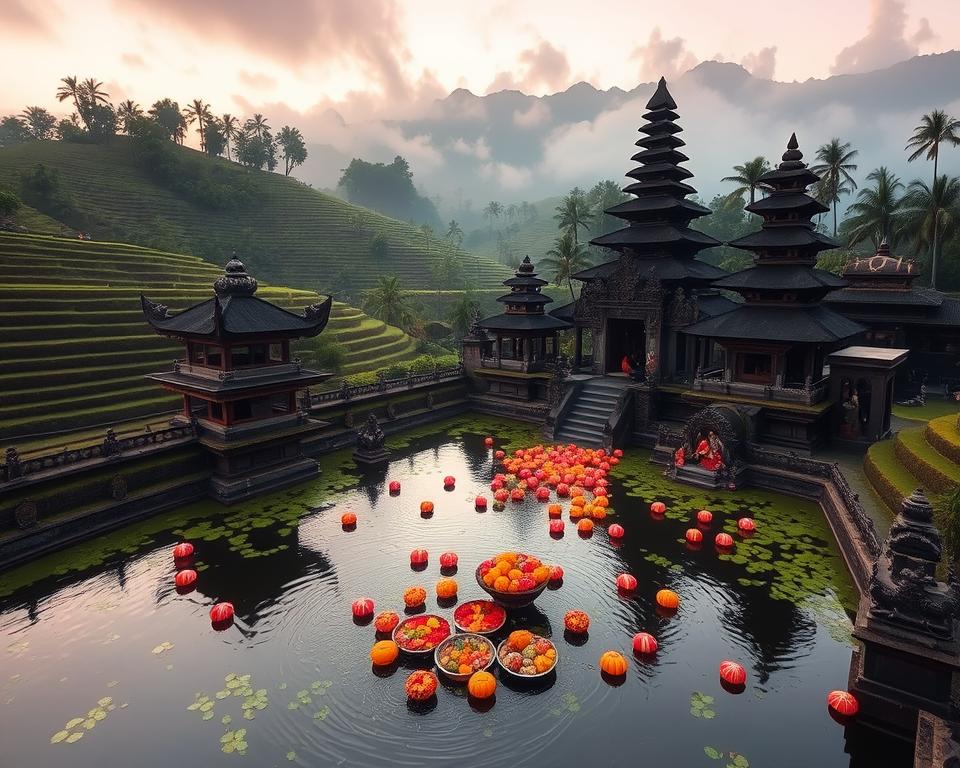
Ubud’s water temples are more than just places. They show the Balinese people’s spiritual and cultural heart13. These sites are important for the Balinese, as places of community, healing, and divine connection13.
“The water purification process at Tirta Empul evokes strong emotional responses from visitors, with feedback including feelings of peace, joy, renewal, and spiritual cleansing, indicating a transformative experience for participants.”
Ubud’s Water Temples and Sustainable Tourism
Bali’s tourism is growing fast. But, we must protect its culture and nature. The water temples in Ubud are very important for this15.
People from Bali and around the world are working together. They want to let visitors see the temples while keeping them safe15. They teach visitors how to be kind to these special places.
The Tri Hita Karana idea is key to the water temples’ importance15. It’s about living in harmony with nature and the divine. The temples help manage water in a way that’s good for everyone15.
They make sure water is shared fairly. This helps the plants and animals around the temples too15.
Ubud’s water temples have a plan for visitors. They want to keep the temples special while also helping the local economy15. Visitors can learn a lot about Bali’s traditions and help protect these places15.
“The water temples of Ubud are not just architectural marvels, but living embodiments of Bali’s deep-rooted connection between spirituality, culture, and the natural world.”
Bali’s tourism is getting bigger. But, we can keep the water temples safe with everyone’s help1516.
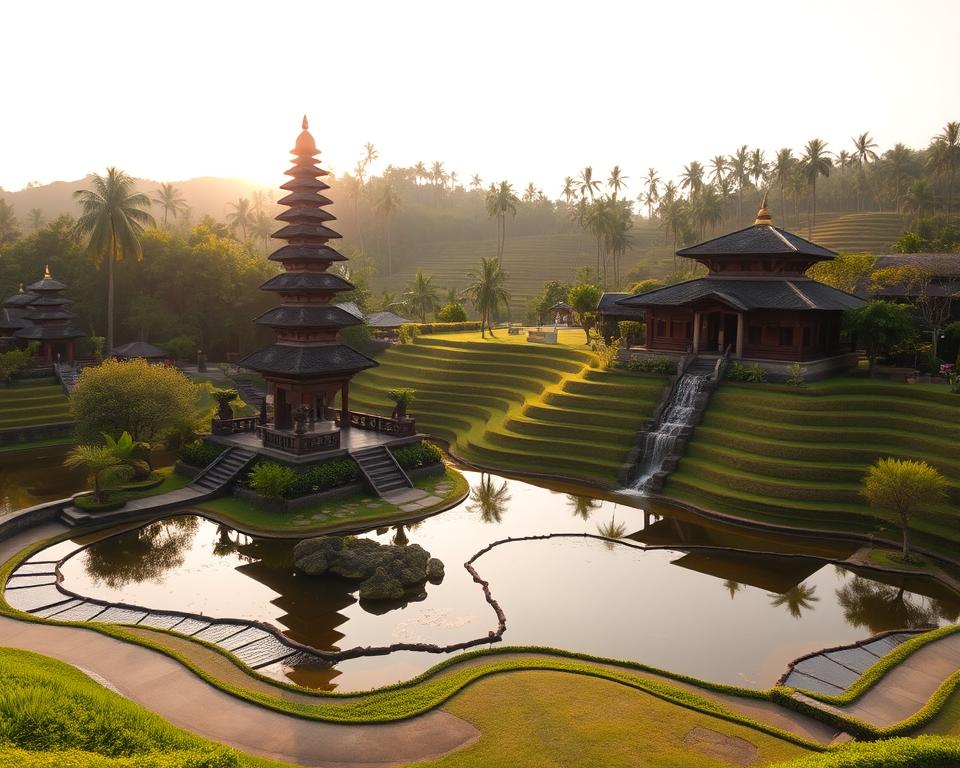
The Future of Ubud’s Water Temples
Bali’s popularity is growing, and Ubud’s water temples face big challenges17. The Tirta Empul Temple is famous for its purification ritual17. It’s a big draw for visitors. But, it’s hard to keep the temples safe while also growing the economy.
Preservation Efforts and Challenges
Local groups and authorities are working hard to save these temples17. They want to control visitor numbers and teach people about being green17. But, it’s tough to keep the temples safe while also welcoming tourists.
Ubud is very popular, with many visitors18. People come for yoga, markets, and spas18. Keeping the temples safe is a big job for everyone involved.
Despite the problems, people are committed to saving the temples17. The Monkey Forest is a big draw, with its monkeys and ancient trees17. Working together is key to keeping these places special for the future.
“The Water Temple in Ubud was a moving spiritual experience for me. It’s a place that truly captures the essence of Bali’s rich cultural heritage.” – Alex B.
Conclusion
The water temples of Ubud show the deep spiritual and cultural value of water in Balinese Hindu belief19. These special places, built near natural springs, let visitors see ancient rituals and stunning buildings. They also learn about the rich history of the Balinese people20.
From famous Tirta Empul to hidden gems, visiting Ubud’s water temples is a special journey. It connects you to the heart of Balinese spirituality.
Bali’s growing fame as a tourist spot means saving these cultural and natural wonders is key20. The Ubud water temples, with their detailed carvings and dances, show the Balinese people’s bond with nature and their sacred beliefs.
Looking for a spiritual journey, a peek into Bali’s culture, or just peace? The water temples of Ubud are a must-see1920. They offer a journey that will stay with you forever.
As you wander these sacred places, you’ll see the wisdom and strength of the Balinese. Their love for water and nature makes Bali so special.
FAQ
What is the significance of the water temples in Ubud, Bali?
The water temples in Ubud, Bali, are very special. They are sacred places in Balinese Hindu culture. People go there for purification rituals, healing, and to connect with the divine.
What is the history and origins of the Ubud water temples?
The water temples in Ubud have a long history. The oldest one, Tirta Empul, was built in 926 AD. They were made around natural springs, showing the importance of water in Balinese Hinduism.
What is the significance of Tirta Empul, the most famous water temple in Ubud?
Tirta Empul is very famous in Ubud. It has natural spring-fed pools and special purification rituals. The name means “holy water spring” in Balinese. Visitors can do the melukat ritual, cleansing themselves under 30 water spouts.
What are some of the other notable water temples in Ubud beside Tirta Empul?
Ubud has more than just Tirta Empul. There’s Pura Ulun Danu at Lake Beratan, a floating temple for Dewi Danu. And Pura Tirta Tawar at Gianyar, known for its natural spring and water rituals.
What is the architectural and symbolic significance of the water temples in Ubud?
The water temples in Ubud are known for their detailed design. They have carved stone gateways, pavilions, and shrines. These show the spiritual importance of water in Balinese Hinduism.
What is the proper etiquette for visiting the water temples in Ubud?
When visiting the water temples in Ubud, wear a sarong. You can rent one at the temple. Remove your shoes before entering. Follow the temple staff’s guidance to respect the rituals and ceremonies.
How do the water temples in Ubud play a central role in Balinese cultural and spiritual life?
The water temples in Ubud are key for purification, healing, and connecting with the divine. Melukat, or bathing in the sacred spring waters, is a big ritual. It cleanses devotees physically and spiritually, showing water’s power to purify and restore harmony.
What are the challenges and preservation efforts surrounding the Ubud water temples?
The rise in tourism poses challenges to the water temples in Ubud. Local and national groups are working to protect these sites. They aim to control visitor numbers, improve infrastructure, and teach about sustainable practices. It’s a tough balance between economic growth and preserving Bali’s heritage.
Source Links
- https://www.indonesia.travel/gb/en/destinations/bali-nusa-tenggara/bali/the-holy-springs-of-tirta-empul.html
- https://www.ubudvillasrental.com/tirta-empul-temple-an-introduction-to-the-holy-place/
- https://thingstoseeinubudbali.com/what-are-the-best-must-see-temples-to-visit-in-ubud-bali/
- https://en.wikipedia.org/wiki/Tirta_Empul
- https://www.raftingbali.net/tirta-empul-temple/
- https://finnsbeachclub.com/guides/best-temples-in-ubud-bali/
- https://discoveryourindonesia.com/activities-around-ubud/
- https://finnsbeachclub.com/guides/pura-taman-saraswati-bali-temple/
- https://www.myguidebali.com/experiences/ubud-water-temples-waterfalls-and-rice-terraces-tour
- https://www.seeingbali.com/article/?art=tampaksiring_gianyar
- https://sabiduri.com/the-sacred-water-temple-in-ubud/
- https://medium.com/@wankhedekaustubh5/balis-water-temples-exploring-the-island-s-spiritual-water-complexes-5e032cec665b
- https://bismacottagesubud.com/blog/why-visit-tirta-empul-temple-and-try-a-balinese-water-purification-ritual/
- https://horizonofreason.com/culture/water-temples-in-bali/
- https://news.mongabay.com/2024/08/in-bali-water-temple-priests-guide-a-sustainable-rice-production-system/
- https://bali-home-immo.com/blog/bali-s-hidden-water-temples
- https://medium.com/@mattievargas/review-top-ubud-monkey-forest-jungle-swing-water-temple-waterfall-an-unforgettable-bali-aaa9058a4236
- https://maddysavenue.com/one-week-in-ubud-guide/
- https://wanderon.in/blogs/pura-taman-saraswati-temple-in-bali
- https://baliagungtrans.com/ubud-water-palace/